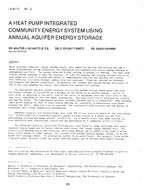
LA-80-12-2 — A Heat Pump Integrated Community Energy System Using Annual Aquifer Energy Storage
These proposed community energy systems employ heat pumps for heating and cooling and use a water distribution system connecting the controlled environments with annual energy storage in underground aquifers. The energy rejected during cooling is stored for heating. The heat sink created during heating is used for cooling. To make the heating and cooling systems effective, heat pumps are used to upgrade the energy to temperatures required for heating and cooling. Four different heat pump-storage combinations are analyzed. These are matched to different environments and ambient conditions. In general, the systems show energy-saving potentials of 30% to 80% over present day energy requirements for heating and cooling.
An underground aquifer system consists of a porous medium through which water can flow. The energy storage is controlled by a minimum of two wells in an aquifer system. As hot or cold water is injected at one well, cold or hot water is withdrawn from the other well at the same rate, resulting in zero net water consumption. The flow direction is reversed for cooling and heating loads. The temperature gradient movement between wells is controlled. Heat exchange takes place similar to that in other porous mediums or, basically, a temperature step moves between the wells. When the flow is reversed, the temperature step reverses and the energy is recovered with little temperature degradation.
Adequate aquifers are located under more than 60% of the populated areas of the continental U.S. Construction of a controlled aquifer energy storage system is a major capital cost; paralleling systems increases overall reliability. As a result, these heat pump systems are most effective when constructed, controlled and maintained by a community and/or a utility.
For different types of controlled environments, from homes to large buildings with major internal energy loads and different ambient conditions, the annual energy demands vary. For systems with heating energy deficiencies, additional energy can be added in the form of waste heat, solar energy or other energy. For systems with excess heating energy, energy can be removed with cooling towers. An alternative method is to match loads. For example, large buildings with major internal loads and excess heating energy can be matched with family housing.
Citation: Symposium, ASHRAE Transactions, Volume 86, Part 1, Los Angeles, California
Product Details
- Published:
- 1980
- Number of Pages:
- 13
- File Size:
- 1 file , 970 KB
- Product Code(s):
- D-LA-80-12-2


